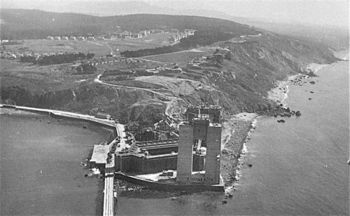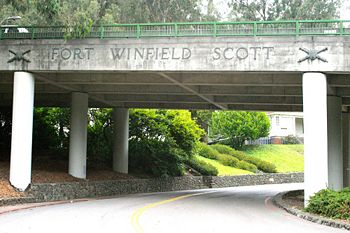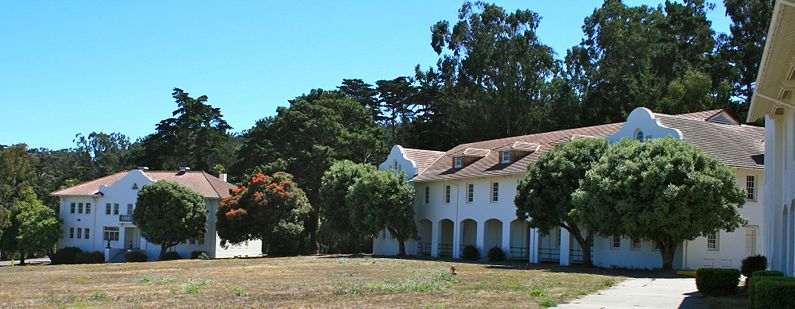Fort Winfield Scott (2)
|
Fort Winfield Scott (2) (1912-1994) - An Endicott Period Coastal Fort established in 1912 on San Francisco Peninsula, San Francisco County, California. Established as an independent coast artillery post and named in G.O. 11, 18 Jun 1912, after Major General Winfield Scott, hero of the Mexican-American War. The post was created from 400 acres on the west and north sides of the Presidio of San Francisco so as to encompass all of the previously built Endicott Period gun batteries. Turned over by the U.S. Army to the National Park Service in 1995 and transferred to the Presidio Trust in 1996.
Endicott Period (1890-1910)Part of the Harbor Defense of San Francisco. The recommendations of the Endicott Board resulted in a massive construction program on Fort Winfield Scott that built some eighteen concrete coastal gun batteries over a period of thirty years. The boundaries of the fort expanded to encompass all of the new gun batteries but additional batteries to the south resulted in the creation of two new forts, Fort Miley and Fort Funston. The northern side of the Golden Gate has a similar expansion during this period at Fort Baker (1) and with the creation of Fort Barry and later, Fort Cronkhite. In 1909, well after the last Endicott Period gun battery was completed, construction of a coast artillery post began. The post was positioned in the northwest quadrant of the Presidio of San Francisco fairly well centered between most of the gun batteries. This was a large ten company post, complete with ten Mission Revival style barracks, a band barracks, officer and NCO housing. The main post buildings surrounded an odd hooked loop parade. In 1912, the post was named after Major General Winfield Scott, made independent of, and allotted 400 acres from the Presidio of San Francisco. Construction continued through 1912 and was virtually complete that year.

World War I (1917-1918)The U.S. entry into World War I resulted in a widespread removal of large caliber coastal defense gun tubes for service in Europe. Many of the gun and mortar tubes removed were sent to arsenals for modification and mounting on mobile carriages, both wheeled and railroad. Most of the removed gun tubes never made it to Europe and were either remounted or remained at the arsenals until needed elsewhere. Fort Winfield Scott was particularly hard hit by the World War I redistribution program. Six batteries had their guns dismounted and shipped overseas or sent to other higher priority locations.Battery Lancaster, Battery Miller, Battery Slaughter, Battery Chamberlin, Battery Boutelle, and Battery Sherwood were disarmed in this manner and only Battery Chamberlin was rearmed after the war. All of the 12" mortar batteries were listed to lose some or all of their mortars and Battery Cranston was also listed to lose its guns. The war ended before these listed actions could take place and these batteries were ordered to remount and retain their guns.  After the end of the war, a rapid disarmament program reduced the size of the Army and the coastal artillery to the point where most posts had to be put in caretaker status for lack of people and funds. A simultaneous program to eliminated obsolete and excess arms caused a further reduction in active batteries. Fort Winfield Scott lost four more batteries, Battery Howe (1), Battery Wagner (1), Battery Blaney and Battery Baldwin to the 1920 disarmament program. Only six batteries remained active after the 1920 disarmament program and all of those would be obsolete by the beginning of World War II. Between 1933 and 1937 the fort was used as a base of operations for the construction of the Golden Gate Bridge. The bridge and the new roadways literally cut Fort Winfield Scott in two, and several of the Endicott Period Batteries were buried beneath the structures and roads. As a result of the construction and the destruction of ammunition storage capacity, a central reserve magazine was built for the post by the bridge authority.

World War II (1941-1945)
Current StatusPart of the Golden Gate Recreation Area (GGNRA) administered by the National Park Service. A National Historic Site since 16 Oct 1970.
Sources:
Links:
Visited: 22-27 Aug 2009 | ||||||||||||||||||||||||||||||||||||||||||||||||||||||||||||||||||||||||||||||||||||||||||||||||||||||||||||||||||||||||||||||||||||||||||||||||||||||||||||||||||||||||||
- Harbor Defense of San Francisco
- Visited
- All
- California All
- California Forts
- California San Francisco County
- Coastal Forts
- Fort Winfield Scott (2)
- Preserved
- National Historic Site
- Endicott Period Forts
- World War I Forts
- World War I Coastal Forts
- World War II Forts
- World War II Coastal Forts
- Display Gun
- Starter Page
- Must See
- 2009 Northern California Trip
- San Francisco NIKE Sites


